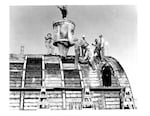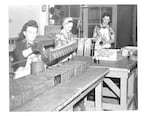The giant metal lock is nearly rusted shut on bunker A-903 at the Umatilla Chemical Depot in northeastern Oregon. Once we’re able to pry it loose and open the 10-foot tall concrete door, we’re walking into a literal time capsule.
Inside the cavernous room, we find boxes and boxes of sealed U.S. Army biscuits, toilet paper, can openers and potable water. One box dates back to January 1964.

Umatilla County Commissioner Bill Elfering exits a bunker at the Umatilla Chemical Weapons Depot in Umatilla County, Ore., on Wednesday, Jan. 30, 2019. The depot and the land it's on will soon be turned over to local control after being operated by the U.S. military for more than 50 years.
John Notarianni / OPB
A-903 is only one of a thousand identical bunkers sprawling in every direction as far as the eye can see at the depot. The rolling hills of the bunkers can be seen for miles from Interstate 84. The entire site covers nearly 20 square miles; for comparison, that’s about the size of the central Oregon city of Bend.
The depot was built in the ramp-up to World War II. For nearly 50 years, 7 million pounds of deadly chemical weapons such as sarin, mustard gas and VX nerve agent were stored here.
Bill Elfering is a Umatilla County commissioner and member of the Columbia Development Authority, the regional board working with the U.S. military to transfer the depot back to local control. He refers to the endless rows of bunkers as "igloos," a strangely cute name for rooms built to house weapons of war. As we tour the site, Elfering points out how they were built in staggered rows.
“There was a concern that one might set the whole thing off and it would be like a string of firecrackers on the Fourth of July," he said. "All of a sudden it just went 'pop, pop, pop.'"

Military rations from 1964 sit in a bunker at the Umatilla Chemical Weapons Depot in Umatilla County, Ore., on Wednesday, Jan. 30, 2019. The depot and the land it's on will soon be turned over to local control after being operated by the U.S. military for more than 50 years.
John Notarianni / OPB
The staggered design was proven to work in 1944 when one of the igloos did explode, killing six people. At the time, the depot’s administrators were only able to tell who had been killed in the blast by having everyone on site clock out after the explosion and then tracking which time cards were left.
“I think the earth would still be shaking if they were to all go off,” Elfering said.
A Time-Consuming Transition
It’s been years since weapons were actually stored at the Umatilla Chemical Depot. A 1993 United Nations resolution banned all use and storage of chemical weapons. In 2004, a massive furnace was built on the property, and all of the weapons were incinerated. The depot officially closed in 2012.
Related: Portland Was Once A Poster Child For Nuclear Preparedness
The property was supposed to return to local control in 2015, but even today, much of the land remains in the hands of the military.
That could be about to change. After years of negotiations, locals are cautiously optimistic that much of the depot’s land will soon be back in local control.
Dr. David Drotzman is the mayor of the nearby town of Hermiston. Hundreds of people from the neighboring community worked at the depot when it was in operation, and a lot of those jobs are gone.
“Were those some good paying jobs? Absolutely," he said. "And have they been replaced with the same level of jobs? Maybe, maybe not.”
He’s eager to see new development.
“Everybody's wish list is Costco. 'When can we get a Costco out there?'" he said. "I think any employer that provides an opportunity for good paying — above you know the state average wages."

Workers building one of the 1,000 "igloos" at the Umatilla Chemical Weapons Depot in 1941.
U.S. Army
The plan to redevelop the depot has several parts. The first phase, converting a portion of the land to a National Guard training center is already well underway. Portions of the land will also be designated as a large nature preserve.
But Elfering says the biggest economic boon could come from developing two stretches of industrial land. The depot lies at the intersection of Interstates 84 and 82, giving it great potential as a transit hub.
“You go 185 miles or 180 miles to the west, and you're in Portland,” Elfering says. “You go a couple hundred miles to the northwest, you're in Seattle. You go a couple hundred miles to the northeast, you're in Spokane. If you go to the southwest, you’re in Boise.”
Mayor Drotzman says that type of development could provide a huge boost to his community.
“Most of those people will be either living here or doing business here, buying their groceries or doing their doctor visit with us," he said. "So it will have a significant impact, and we need to be prepared. We want to start that process, and so that's where the frustration comes from.”

Women work on a line of grenades at the Umatilla Chemical Weapons Depot during World War II.
U.S. Army
While the years of delays have been frustrating to many locals, another group has been waiting much longer to return to the site.
Bill Tovey is with the Confederated Tribes of the Umatilla Reservation. The depot runs through his nation's hunting and gathering lands, including the religiously-significant Coyote Coulee. He’s eager to see the land to return to the tribes so they can begin rehabilitating the land.
“There's been wildfires that have went through there,” he said. “It’s burnt the shrub-steppe habitat. So there’s a lot of cheatgrass and foreign species. We want to reclaim the land and put more natural species in there.”
Related: Umatilla's Owl Man Is Bringing Burrowing Owls Back From The Brink
Bill Elfering says the number of stakeholders has made what initially looked like a straightforward process much more cumbersome.
Each group has had its own specific interests at heart: protecting natural areas, preserving sacred lands, providing security for military assets and making sure the economic benefits are evenly distributed. Those competing interests have occasionally led to gridlock. But, Elfering says the coalition is closer than ever to an agreement.
“We need one more piece of paper, maybe two more pieces of paper that say it meets their objectives,” he said.
Until then, the 1,000 bunkers at the Umatilla Chemical Depot remain empty – aside from the occasional stash of vintage army supplies.
Editor's note: A previous version of this story attributed a statement about the Confederated Tribes of the Umatilla Reservation to the wrong tribal official. That quote was stated by Bill Tovey, the tribe’s economic and community development director.

